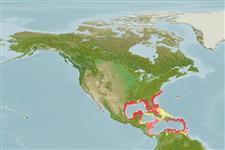Environment: milieu / climate zone / depth range / distribution range
Ecologia
marinhas; estuarina associadas(os) a recifes; intervalo de profundidade 1 - 171 m (Ref. 9710). Subtropical; 37°N - 9°N, 98°W - 59°W
Western Atlantic: North Carolina, USA to Venezuela, including the Bahamas, Gulf of Mexico and the Antilles. Probably occurring around Trinidad (Ref. 5217). Rare around islands (Ref. 51183).
Tamanho / Peso / Idade
Maturity: Lm ? range ? - ? cm
Max length : 27.0 cm TL macho/indeterminado; (Ref. 5217); common length : 22.5 cm TL macho/indeterminado; (Ref. 5217); peso máx. Publicado: 275.00 g (Ref. 5217)
Descrição breve
Morfologia | Morfometria
Espinhos dorsais (total): 8; Raios dorsais moles (total): 13; Raios anais moles: 11. Caudal fin has 3 dark vertical bars. Long filament on nostril. Fleshy tentacle above eye. No other searobin has filaments on the nostril and fleshy tentacles above the eye (Ref. 26938)
Found from bays and estuaries to the mid-shelf.
Life cycle and mating behavior
Maturidade | Reprodução | Desova | Ovos | Fecundidade | Larvas
Robins, C.R. and G.C. Ray, 1986. A field guide to Atlantic coast fishes of North America. Houghton Mifflin Company, Boston, U.S.A. 354 p. (Ref. 7251)
Categoria na Lista Vermelha da IUCN (Ref. 130435)
Ameaça para o homem
Harmless
Utilização humana
Mais informação
Idade/TamanhoCrescimentoComprimento-pesoComprimento-comprimentoFrequência de comprimentoMorfometriaMorfologiaLarvasDinâmica larvarRecrutamentoAbundânciaBRUVS
ReferênciasAquaculturaPerfil para aquaculturaEstirpesGenéticaElectrophoresesHereditariedadeDoençasProcessamentoNutrientsMass conversion
ColaboradoresFotografiasStamps, Coins Misc.SonsCiguateraVelocidadeTipo de nataçãoÁrea branquialOutras referênciasCérebrosVisão
Ferramentas
Relatórios especiais
Descarregue XML
Fontes da internet
Estimates based on models
Preferred temperature (Ref.
123201): 22.4 - 27.8, mean 25.8 °C (based on 368 cells).
Phylogenetic diversity index (Ref.
82804): PD
50 = 0.5000 [Uniqueness, from 0.5 = low to 2.0 = high].
Bayesian length-weight: a=0.00525 (0.00220 - 0.01254), b=3.13 (2.92 - 3.34), in cm total length, based on LWR estimates for this (Sub)family-body shape (Ref.
93245).
Nível Trófico (Ref.
69278): 3.6 ±0.6 se; based on size and trophs of closest relatives
Resiliência (Ref.
120179): Médio, tempo mínimo de duplicação da população 1,4 - 4,4 anos (Preliminary K or Fecundity.).
Fishing Vulnerability (Ref.
59153): Low vulnerability (17 of 100).
Nutrients (Ref.
124155): Calcium = 42.9 [16.4, 101.7] mg/100g; Iron = 0.659 [0.327, 1.382] mg/100g; Protein = 17.5 [15.1, 20.6] %; Omega3 = 0.249 [0.104, 0.710] g/100g; Selenium = 19.3 [7.9, 46.2] μg/100g; VitaminA = 90.9 [29.1, 295.0] μg/100g; Zinc = 0.927 [0.564, 1.439] mg/100g (wet weight);
